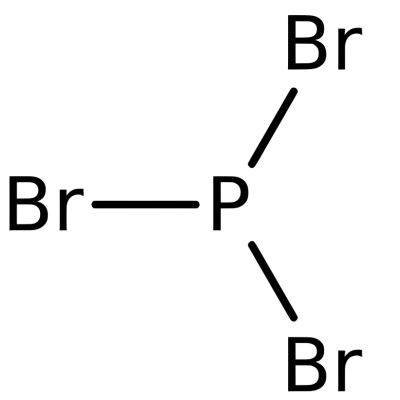
Tribromophosphine; Phosphorus(III) bromide; PBr₃; Phosphorous tribromide
CAS 7789-60-8
Chemical Formula PBr₃
Molecular Weight 270.69 g/mol
Phosphorus tribromide is a reactive chemical compound commonly used in organic synthesis to convert alcohols into alkyl bromides. It is also employed in the manufacture of pharmaceuticals, agrochemicals, and flame-retardant compounds.
1. Pharmaceuticals
2. Agrochemicals
3. Performance Chemicals
4. Polymers & Resins
| Assay | ≥ 99% (typical reagent grade) |
|---|---|
| Appearance | Colorless to pale yellow fuming liquid |
| Odor | Pungent, irritating odor |
| Boiling Point | 173.2 °C |
| Melting Point | -41.5 °C |
| Density | 2.85 g/cm³ at 20 °C |
| Solubility | Reacts with water; soluble in benzene and chloroform |
| Viscosity | ~1.15 mPa·s at 20 °C |
| Flash Point | Non-flammable, but decomposes violently with moisture |



1. What is the current price of Phosphorus tribromide in India?
The price Phosphorus tribromide can vary based on factors such as purity, quantity, etc. For the most accurate and competitive pricing, please contact us at +91.630 100 6301 directly for a customized quote tailored to your needs.
2. Where can I buy Phosphorus tribromide in India?
You can purchase Phosphorus tribromide from MULTICHEM, a leading exporter with a reputation for quality and reliability. We provide convenient options for bulk orders and direct shipments global markets. For more details on how to place an order, please visit our website or contact our sales team.
3. What is the minimum order quantity (MOQ) for Phosphorus tribromide?
Our minimum order quantity (MOQ) Phosphorus tribromide is designed to cater to both small-scale and large-scale needs. The MOQ depends on the packing size of the product which could range from 25 kg to 250kg.
4. How can I ensure the quality of Phosphorus tribromide supplied by Multichem?
We adhere to stringent quality control processes to ensure that our products meet the highest standards of purity and effectiveness. They undergo rigorous testing and quality checks to guarantee that they comply with industry specifications. We provide a Certificate of Analysis (CoA) with every shipment to ensure transparency and quality assurance.